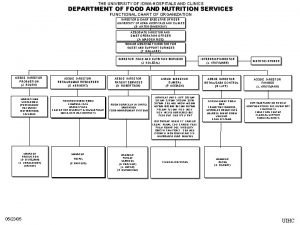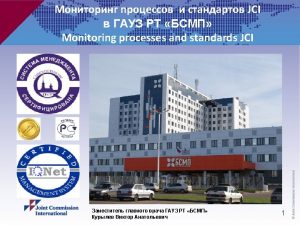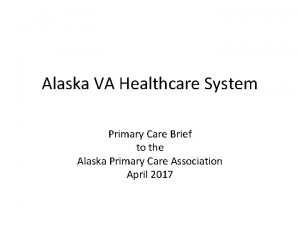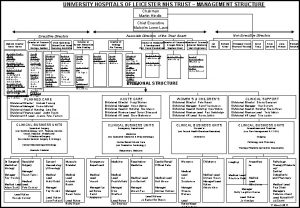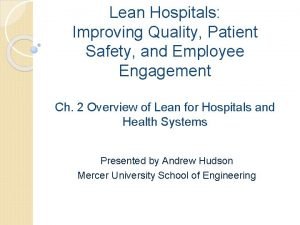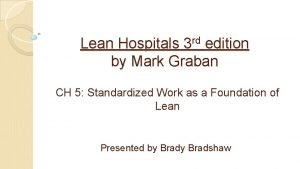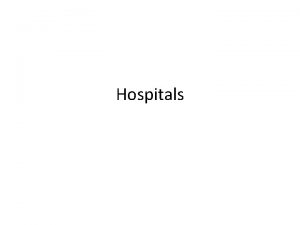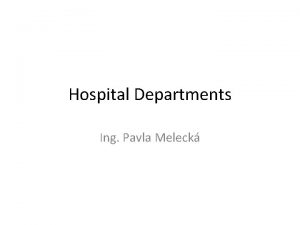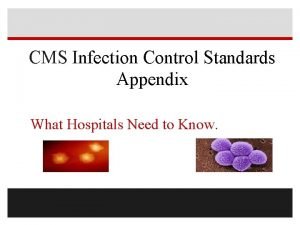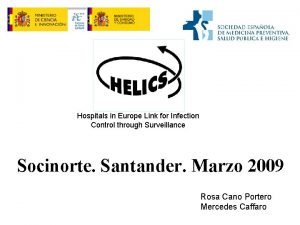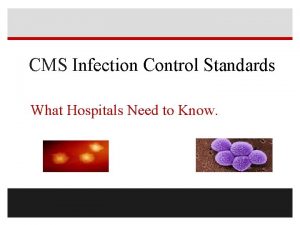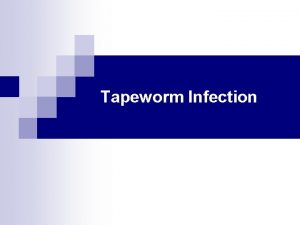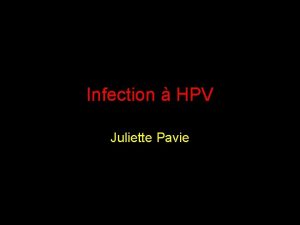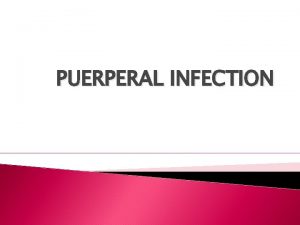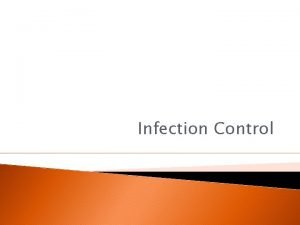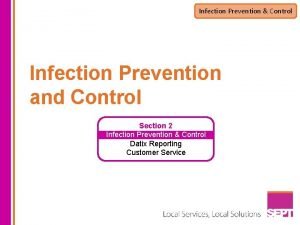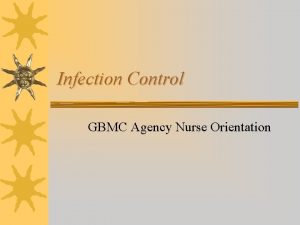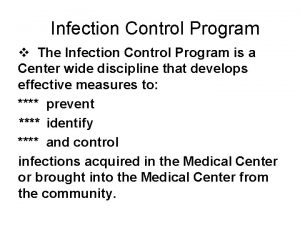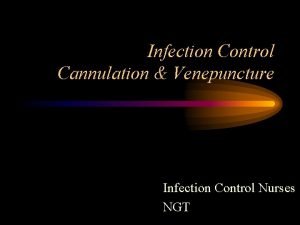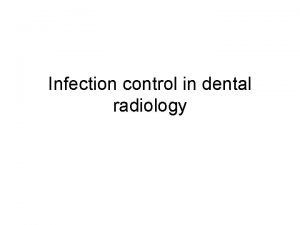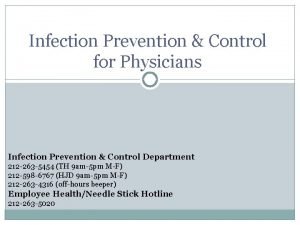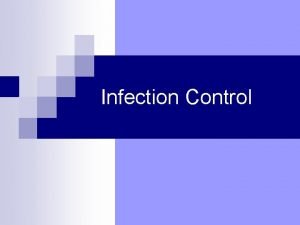INFECTION CONTROL Why is Infection Control Important Hospitals

























- Slides: 25

INFECTION CONTROL

Why is Infection Control Important?

“Hospitals should do the sick no harm”. Florence Nightingale (1859)

Patients are vulnerable to infection

• • WHERE CAN MICROORGANISMS BE FOUND ? Environment People Equipment Food WHAT DO MICROORGANISMS NEED TO GROW? • • Warmth Moisture Food source Time

HOW DO THEY SPREAD? • Hands • Through the air • Via equipment e. g. Commodes • Puncture of the skin • Food • • An infected person Droplets Contact Skin scales

Standard precautions are the minimal level of infection control precautions that apply to all patients at all times in all situations.

Who is responsible for implementing Standard Precautions?

We all are. All NHSGGC employees must follow the requirements of the Standard Precautions Policy – See your ward Infection Control Manual for information.

PPE Hand hygiene Masks and Eye protection There are 10 elements to Standard Precautions Environment Clinical Waste Isolating infectious patients Spillages Patient care equipment Linen Cough Etiquette Occupational Exposure

Hand Hygiene The simplest and most effective method of preventing the spread of infection

Hand Hygiene • Simple and effective • Proven to reduce the risk of acquiring HAI • Use of alcohol gels • Performed between each patient intervention • Ensure technique is good

Wet hands, apply soap. Palm to palm. Backs of fingers to opposing palms with fingers interlocked. Right palm over left dorsum and left palm over right dorsum. Rotational rubbing of right thumb clasped in left palm and vice versa. Palm to palm fingers interlaced. Rotational rubbing, backwards and forwards with clasped fingers of right hand in left palm and vice versa.


Alcohol Hand Gel • Used as a compliment to handwashing not a replacement • Good for rapid disinfection of skin • Can only be used on physically clean hands • Suitable for use on ward rounds between patients. • Should only be used up to 5 times then wash hands with soap and water • Placed at every bed space within NHSGGC

PERSONAL PROTECTIVE EQUIPMENT (PPE) • • • Gloves Aprons Eye protection Face shields Masks

Isolation Protective Source • Vulnerable patients, • Patients identified as with poor immune carrying bugs that systems. could cause other patients to become • Patients who may be ill if it was passed receiving onto them. chemotherapy • Stop these patients catching an infection

Methicillin Resistant Staphylococcus Aureus (MRSA) • • What is MRSA? What are the predisposing risk factors? What is colonised, What is infected? How is MRSA transmitted

MRSA screening • • • Who should be screened When should they be screened What samples should be taken What treatment should be given What about isolation

Clostridium difficile Symptoms • Watery, foul smelling stools. • Abdominal pain. • Pyrexia (high temperature) • Dehydration.

How to prevent spread of Clostridium Difficile to other patients • • If they have diarrhoea send a sample. Isolate them in a side room. Use Personal Protective Equipment. Encourage the patient to wash their hands after using the toilet. • Clean the commode thoroughly after every use with Actichlor Plus.

OUTBREAKS

OUTBREAKS • • • What is an outbreak When should infection control be notified What information is required Can patients be discharged/transferred Can patients attend for examinations e. g. xray • Enhanced cleaning • Outbreak is over, what now?

BRISTOL STOOL CHART Long Transit e. g 100 hours Type 1 Separate hard lumps, like nuts hard to pass Type 2 Sausage shaped but lumpy Type 3 Like sausage but with cracks on the surface Type 4 Like sausage or snake, smooth and soft Type 5 Soft blobs with clear cut edges (passed easily) Type 6 Fluffy pieces with ragged edges, a mushy stool Type 7 Short transit e. g 10 hours Watery, no solid pieces Types 1 -5 do not send specimens to microbiology. Types 6 and 7 send specimens to microbiology

Prevention and Control of Infection Team • There are Prevention and Control of Infection Teams available for specialist Infection Control advice within NHSGGC • Contact details of local Infection Control Teams (ICT) can be found within NHSGGC Prevention and Control of Infection Manual, via your local switchboard or website; www. nhsggc. org. uk/infectioncontrol
 Hey hey bye bye
Hey hey bye bye Dont ask
Dont ask Mandatory standards examples
Mandatory standards examples University of iowa hospital and clinics departments
University of iowa hospital and clinics departments Qah
Qah Ldh health standards
Ldh health standards Jci
Jci Echs visakhapatnam
Echs visakhapatnam What are the uses of computer in hospital
What are the uses of computer in hospital Dnv regulations for hospitals
Dnv regulations for hospitals Bcp for hospitals
Bcp for hospitals Anchorage va medical center
Anchorage va medical center Uhcw parking permit
Uhcw parking permit Worcestershire acute hospitals nhs trust
Worcestershire acute hospitals nhs trust Strength and weakness
Strength and weakness Lean hospitals
Lean hospitals Graban lean hospitals download
Graban lean hospitals download Fhpl gpla certificate
Fhpl gpla certificate Erp for hospitals
Erp for hospitals Medisep hospitals in kerala
Medisep hospitals in kerala Dr sue carr
Dr sue carr Bed management in hospitals
Bed management in hospitals Upper peninsula hospitals
Upper peninsula hospitals Portsmouth hospitals nhs trust jobs
Portsmouth hospitals nhs trust jobs National accreditation board for hospitals
National accreditation board for hospitals Lokmanya tilak hospital chinchwad
Lokmanya tilak hospital chinchwad



